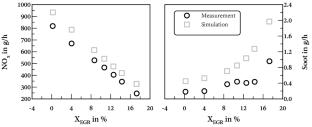Application of a combined physical and data-based model for improved numerical simulation of a medium-duty diesel engine
Abstract
The one-dimensional computational fluid dynamics (1D-CFD) simulation is an important development tool for improving the matching process of the exhaust gas turbocharger with a combustion engine. To meet future emission requirements of commercial vehicles, an increasing focus on transient operation conditions is given. For example, a faster boost pressure build-up allows higher exhaust gas recirculation rates during load steps—improving transient nitrogen oxides (\(\hbox {NO}_x\)) emissions. According to this, the matching process of the turbocharger focuses increasingly on the transient operation conditions of combustion engines. To increase the quality of the dynamic engine process simulation, the simulation model should be optimized with regard to the quality of the engine’s high-pressure process including emissions as well as the turbocharger modeling methodology. This paper focuses on the application of an approach that combines a data-based combustion model for the \(\hbox {NO}_x\) and soot values and the high-pressure part of the working process with a physical description of the gas exchange. To generate the data for the combustion model, an extensive measurement campaign of all relevant parameters was carried out on a medium-duty diesel single-cylinder research engine. The developed model was integrated into a multi-cylinder engine (MCE) simulation environment and validated on the basis of corresponding MCE measurements. The sensitivities of the model were examined for the input parameters. The data-based combustion model demonstrates a high accuracy in emissions and high-pressure working process modeling both in the wide range of the engine map and under transient operating conditions as well as for different engine calibration strategies. As a result, a good baseline for the improved transient combustion simulation is provided.


 求助内容:
求助内容: 应助结果提醒方式:
应助结果提醒方式:


